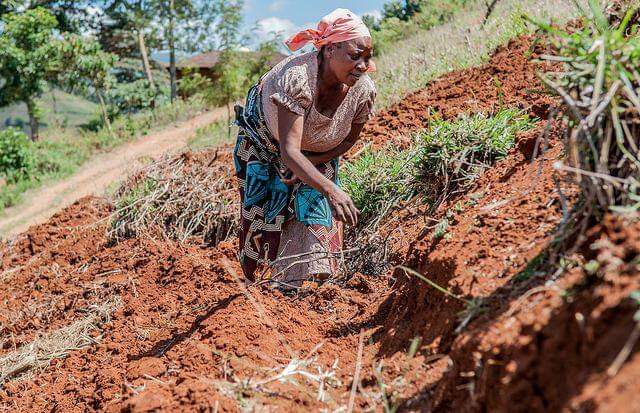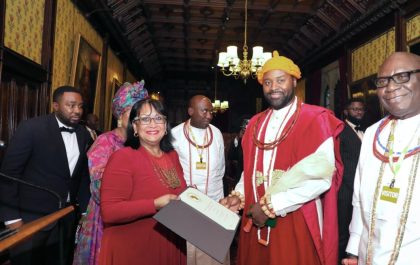-Raheem S Ayeni
Nigeria is a rich country with a booming population of over 200 million people. While this richness is an
advantage, the country’s human development has, however, been severely impacted by multidimensional
poverty.
In 2015, President Muhammadu Buhari inherited an economy that was depressed, a people in dire need,
and global poverty statistics that projected a steady descent into poverty. The government prioritised these
issues by launching two key interventions, among other initiatives: first, the National Social Protection Policy,
which serves as the guidebook for addressing inequalities, highlights the social benefits accruable to each
citizen, and provides insights on public policy issues of distribution and protection, especially for the poor and
vulnerable. The second was the establishment of the National Social Safety-Nets Project (NASSP), which has
in its custody the largest number of identified poor and vulnerable households in Nigeria.
Nigeria is a nation of riches and poverty splendid, wealth in the hands of few and extreme/abject poverty at the doorsteps of many. This study examined the role of economic growth, agriculture and quality of governance in explaining the wide differences in poverty level in Nigeria. The study used a 25-year period (1990 – 2015) time series secondary data. Data were analysed using Impulse Response Function (IRF) and Autoregressive Distributed Lag Model (ARDL). IRF revealed that there was a negative and positive response of POV to shocks in real GDP in Nigeria. ARDL showed that real GDP, inflation and unemployment are a key variables that can be used to enhanced poverty reduction and significant in both the short and long run. Similarly, education and agriculture value added also have a negative coefficient in the short run analysis which means the variables will lead to poverty reduction in the short run. The study recommended that pro poor policies should be designed for alleviating poverty and this should be cantered on diversifying the Nigerian economy with agriculture so that the benefits of economic growth will trickle down to the agro-based rural population that constitute a larger proportion of the poor people.
Poverty in the face of abundance is now the world’s greatest challenge and major developmental objective is the achievement of equality in the distribution of income and reduction of poverty. About 2.8 billion persons of the world’s population live on less than $2 a day, and 1.4 billion on less than $1 a day (World Bank, 2009).
According to the National Bureau of Statistics (2012) report, 112.519 million out of an estimated 163 million of Nigeria’s population live in relative poverty. Relative poverty is the comparison of the living standard of people living in a given society within a specified period of time. Apart from the relative poverty index, Nigeria failed all poverty tests using all poverty measurement standards: absolute poverty measure puts the country’s poverty profile at 60.9 percent; the dollar per day measure puts the poverty profile at 61.2 percent and the subjective measure puts the poverty profile at 93.9 percent (NBS 2012). The Human Development Index (HDI) of 0.423 also ranks Nigeria 142 out of 169 countries in
2010 with estimated GNI per capita of $2156, life expectancy at birth of 48.4 years, Multidimensional
Poverty Index (MPI) of 0.368 (UNDP, 2010).
The average Nigerian is a poor man. Nigeria is a nation of riches and poverty splendid, wealth in the hands of few and extreme/abject poverty at the doorsteps of many. The divergence between Nigeria’s economic indicators, macroeconomic variables and the reality is a source of concern. The reality is that people die because they cannot afford three square meals a day as well as access basic public healthcare.
As strange as this may sound, this goes on side-by-side with ostentatious display of wealth by the privileged few.
These problems are traceable to weak governance that the nation has experienced over the years, which are due to a combination of inefficient service delivery and inconsistent policy settings. In an attempt to proffer solution to the foregoing problems, it is therefore imperative to determine the role of economic growth, agriculture and quality of governance in explaining the wide differences in poverty in Nigeria. The role of governance in explaining poverty was accessed by introducing some indicators like education, infrastructure, corruption perception and absence of violence/political instability in the countries into the model. In additions to these, the role of agriculture was also assessed by introducing a variable on agriculture value added and agricultural land.
The MPI data in this report provide insightful information at national and state levels, placing at the disposal of actors and policymakers a tool to pinpoint levels of deprivations experienced by people up to senatorial districts, the kind of policy changes required for the reforms needed, and the need for State and private sector participation to move the needle with every targeted investment effort. The Nigeria MPI is thus positioned to play a pivotal role in the hands of discerning stakeholders: policymakers at various levels of government, academia, civil society and the public.
The Nigeria Poverty Map (NPM) has been created as a more user-friendly version of this report and visually presents the data findings for each indicator, State, senatorial district, and disaggregated analyses related to: children, gender, and people living with disabilities, among others.
Home to over 200 million people, Nigeria is the most populous country on the African continent and the seventh largest in the world. The United Nations forecasts that the population will double by 2050, making it the third largest country in the world (UNDESA, 2019). Given Nigeria’s size and growth potential, the pressure to safeguard and improve the lives of its citizens is significant. Nigeria was still recovering from its 2016 economic recession when another recession hit in 2020 due to the effects of the COVID-19 pandemic, further derailing its economic recovery. While the COVID-19 regulatory measures implemented in Nigeria helped to control the spread of the virus, many of these necessary and lifesaving measures had deleterious effects on livelihoods, health, human wellbeing, state–society relations and social harmony. The Nigerian economy has grown post-COVID, with the real Gross Domestic Product (GDP) growth rate rising from -1.92% in 2020 to +3.40% in 2021. Despite this economic recovery, the lingering impact of the 2020 recession has undermined household welfare and exacerbated poverty and vulnerability.
In August 2019, the President of Nigeria committed to empowering an additional 100 million people to escape extreme poverty by 2030. This means that, on average, 10 million people must be lifted out of poverty each year, starting from 2020. With the adverse impact of COVID-19 on livelihoods, and unemployment, this challenge has become even more important.
It is within this context that the Nigeria MPI (2022) survey was conducted across the 109 senatorial districts, establishing a baseline for the local government area (LGA) survey due in 2023, and future two-yearly national surveys.
Related posts
Global | Didi Angaye Earns A Distinction Award, Another Feather To The Cap
On a bright sunny day, in the month of July, 2024, the prestigious Staffordshire University located in the West Midlands of England organised its Award giving and Graduation ceremony to honour graduates of various educational programmes and courses which it offers. Didi Timipah Angaye,…
Olu Of Warri Bags Award In UK, Wife Advocates Return To Cultural Values
The Olu of Warri, Ogiame Atuwatse III, has received the Leadership and Community Development award at the 14th African Achievers Awards (AAA), which took place at the Parliament House, United Kingdom. The award was presented by a member of the House of Lords, London, Rt…
Brit Awards | Asake, Burna Boy And Other ‘New Cats’ Get Nominations
Nigerian singers Burna Boy, Asake, and Rema have been nominated for the 2024 Brit Awards. The nomination list for the annual music awards show was released on Wednesday 25, January 2024. Burna Boy and Asake made the ‘Best International Artiste’ category, while ‘Calm…
Brit Awards 2024 | The Full List Of Artist(e)s
This year’s Brits nominees have been revealed ahead of the ceremony in London in March. Dua Lipa is the first star confirmed to perform at the event – but how many awards is she up for? Musicians including Raye, Central Cee, J Hus and Blur are also…
Top 10 Cryptocurrencies To Invest in January 2024
-Michael Adams From Bitcoin and Ethereum to Dogecoin and Tether, there are thousands of different cryptocurrencies, making it overwhelming when you’re first getting started in the world of crypto. To help you get your bearings, these are the top 10 cryptocurrencies based on their market…
The Risk And Reward Of ChatGPT In Cybersecurity
Juan is an experienced CTO with a demonstrated history of working in the computer and network security industry. He is an information technology professional skilled in SAP and Oracle applications, computer forensics, vulnerabilities research, IPS/IDS and information security. Unless you’ve been on a retreat in…
Explained – History Of Money From Fiat To Crypto
What is money? Money as a concept has been a cornerstone of human civilization and economic development. To start with the latter, money is a method of storing value and worth, and it also functions as a medium of exchange that allows individuals to exchange…
Studies Show That Nigerian Crypto Foreign Investment Is At A Record Low
Foreign direct investment in Nigeria fell by 33% last year due to a severe shortage of dollars, which discouraged crypto companies from expanding into the country. The largest economy in Africa has a foreign investment problem despite exponential growth in crypto adoption. The National Bureau…












